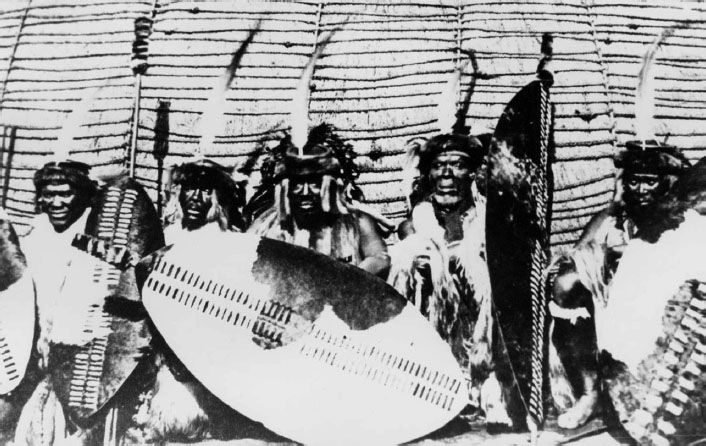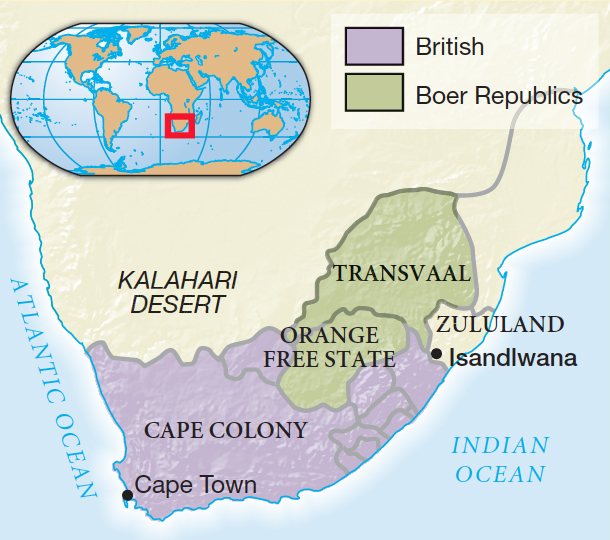Beyond America’s Borders: Imperialism, Colonialism, and the Treatment of the Sioux and the Zulu
Printed Page 452 Chapter Chronology
Imperialism, Colonialism, and the Treatment of the Sioux and the Zulu

Viewed through the lens of colonialism, the British war with the Zulu in South Africa offers a compelling contrast to the war of the United States against the Lakota Sioux. The Zulu, like the Sioux, came to power as a result of devastating intertribal warfare. In the area that is today the KwaZulu-Natal province of the Republic of South Africa, the Zulu king Shaka united his empire by 1826 with an army of more than twenty thousand. And like the Sioux, the Zulu earned a formidable reputation as brave warriors who fought to protect their land from white encroachment.
In 1806, the British seized the Cape of Good Hope to secure shipping interests, leading to conflicts with Dutch-speaking settlers there known as the Boers, who had inhabited the southern tip of Africa since the seventeenth century. Clashes between Britons and Boers eventually resulted in the Great Trek, the migration of nearly twelve thousand Boers northeastward beginning in 1835. There they claimed land and established the South African Republic (the Transvaal) in 1853 and the Orange Free State in 1854, both independent of British rule. But the Great Trek brought the Boers into Zululand, where they met with bloody resistance.
The Zulu lived in a highly complex society, with regiments of warriors arranged by age and bound to local chiefs under the supreme command of the Zulu king. During his harsh reign, King Shaka inspected his regiments after each battle, picking out cowards and putting them to death on the spot. Young men could not start their own households without the local chief's permission, thus ensuring an ample stock of warriors and making the Zulu army, in the words of one English observer, "a celibate, man-slaying machine." The Boer settlers repeatedly faced the wrath of the Zulu, who slaughtered the first trekkers to arrive in Zululand and raided Boer settlements to steal cattle.

The British entered the fray in 1879, sparking the Anglo-Zulu War, which a recent historian has condemned as being "as unnecessary as it was unjust." Sir Theophilus Shepstone, British secretary for native affairs, hinted at Britain's motive when he wrote in 1878, "Had [its] 30,000 warriors been in time changed to labourers working for wages, Zululand would have been a prosperous peaceful country instead of what it is now, a source of perpetual danger to itself and its neighbors."
With aims of both placating the Boers and securing a source of labor for British economic expansion — made paramount by the discovery of diamonds in the region — British troops invaded Zululand. Leading soldiers armed with the latest rifles and artillery, Lord Chelmsford — with a confidence reminiscent of that of George Armstrong Custer — expected to subdue the Zulu easily. But in January 1879, at the battle of Isandhlwana, the Zulu army of more than 25,000 surprised a British encampment. In less than two hours, more than 4,000 Zulu and British were killed. Only a handful of British soldiers managed to escape, and Chelmsford lost 1,300 officers and men.
When news of Isandhlwana reached London, commentators compared the massacre to Custer's defeat at the Little Big Horn and noted that native forces armed with spears had defeated a modern army.
The British immediately launched unconditional war against the Zulu. In the ensuing battles, neither side took prisoners. The Zulu beat the British twice more, but after seven months the British finally routed the Zulu army and abandoned Zululand to its fate — partition, starvation, and civil war.
Historians would later compare the British victory to the U.S. Army's defeat of the Sioux in the American West, but the Zulu and Sioux met different economic fates. As Shepstone hinted in 1878, the British goal had been to subdue the Zulu and turn them into cheap labor. Compared to the naked economic exploitation of the Zulu, the U.S. policy toward the Sioux, with its forced assimilation on reservations and its misguided attempts to turn the nomadic tribes into sedentary, God-fearing farmers, may seem less exploitative if no less ruthless in its cultural imperialism.
Both the Little Big Horn and Isandhlwana became legends that spawned a romantic image of the "noble savage": fierce in battle, honored in defeat. Describing this myth, historian James Gump, who has chronicled the subjugation of the Sioux and the Zulu, observed, "Each western culture simultaneously dehumanized and glamorized the Sioux and Zulu," and noted that the noble savage mythology was "a product of the racist ideologies of the late nineteenth century as well as the guilt and compassion associated with the bloody costs of empire building." Imperial powers, both Britain and the United States defeated indigenous rivals and came to dominate their lands (and, in the case of the Zulu, their labor) in the global expansion that marked the nineteenth century.
America in a Global Context

How was the British war with the Zulu similar to and different from the American war with the Sioux?

Compare the fate of the defeated Zulu with that of the Sioux.
CONNECT TO THE BIG IDEA

Why did the American government put Native Americans on reservations during the late nineteenth century?